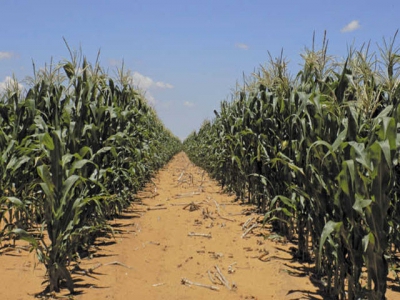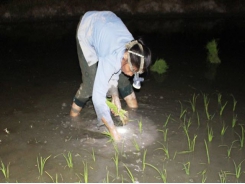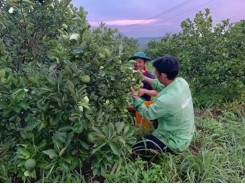Managing resistance of African stem borer to BT-maize

Andri Visser, a doctoral student at the Unit for Environmental Sciences and Management at North-West University, explores how assumptions about the behaviour of the African stem borer affect the resistance management strategy and sustainability of Bt-maize.
Bt-crops could contribute significantly to food security in Africa by increasing yields, especially in rural areas where access to chemical control for pests is limited. Photo: FW Archive
The African stem borer has proved a formidable foe for maize producers in South Africa. In 2006, the first Busseola fusca populations resistant to Bt-maize were documented, a mere eight years after the commercial release of the genetically modified (GM) crop in South Africa.
At that stage, it was one of only three insect pest species in the world able to overcome a Bt-toxin, and has since rendered MON 810, the first Bt-event, impotent in most growing areas in South Africa.
With the release of the stacked Bt-event, MON 89034, the slate has been wiped clean: all B. fusca populations are once again susceptible to the new Bt-maize.
This has offered researchers a rare second chance to better manage the sustainability of this crop for SA producers.
In The Art of War, Sun Tzu offers the following wisdom: “If you know the enemy and know yourself, you need not fear the result of a hundred battles.”
Perhaps it’s time to re-evaluate what we know, and what we think we know, about insect resistance management for Bt-crops.
GM crops have been grown in South Africa for 20 years. Currently, three GM crops are cultivated here, namely maize, soya bean and cotton.
The production of Bt-maize has increased exponentially over this time, peaking at 2,36 million hectares in 2013.
Bt-maize contains genetic material from the Bacillus thuringiensis bacterium; this enables the plants to produce crystal proteins that are toxic to certain pest species, but harmless to humans and livestock.
As a result, farmers no longer need to apply multiple sprays of harmful broad-spectrum insecticides to control pest populations.
Because the Bt-toxins are so effective at controlling the stem borer larvae, only the extremely rare resistant individuals in the pest population survive on Bt-maize.
These are therefore the only members of the population to propagate, and their resistance genes are passed on to their offspring.
This leads to the onset of resistance in the population, which is the greatest threat to the sustainability of Bt-crops.
This risk was identified even before the commercial release of Bt-crops, and various insect resistance management strategies were proposed.
In the end, the high-dose/refuge (HDR) strategy was deemed best, and its implementation was made mandatory whenever Bt-crops are cultivated.
Refuge area
The HDR strategy requires that a refuge area of non-Bt-maize be grown in close proximity to the Bt-maize.
These plants harbour a large portion of the pest population, most of which are susceptible to the toxins in Bt-maize.
The great number of susceptible individuals arising from the refuge plants outnumber the rare resistant individuals that survive on the Bt-maize, greatly lowering the chance that these resistant individuals will mate with each other.
The hybrid offspring created when the resistant adults mate with the susceptible adults are not sufficiently resistant to survive the Bt-toxins, and will die when they feed on Bt-maize.
This ensures that the genes for Bt-resistance are diluted with susceptible genes, thereby delaying the evolution of resistance.
The refuge area can be structured in several ways, including mixed seed refuges (also known as refuge-in-a-bag).
The HDR strategy is based on several assumptions, and studies have shown that violating these undermines the efficacy of the technique.
Three key assumptions are always investigated for the target pest species before a Bt-crop is released for commercial use. These are:
Low initial occurrence of resistance genes in the pest population;The presence of a large refuge area that sustains production of many susceptible individuals;
A high concentration expression of the Bt-toxins in the Bt-plants.
B. fusca probably developed resistance because the second and third assumptions were violated.
Apart from these three key assumptions, there exist other implicit assumptions about the behaviour of the target pest that are not well examined or understood.
These include assumptions about how the female moths select plants on which to lay their eggs, the factors that influence how larvae migrate within a cropland, how Bt-toxins are expressed within a plant, and how the surrounding fields and environmental conditions affect the HDR strategy.
For example, HDR takes it for granted that adult females are unable to detect the Bt-toxins inside plants, and will therefore randomly select a plant on which to lay eggs.
That is, females do not display behaviour that suggests a preference for either Bt- or non-Bt-maize.
However, studies of the fall armyworm (Spodoptera frugiperda) show that, under certain conditions, the females show a strong preference for Bt-maize when selecting a plant on which to lay eggs.
This behaviour will inevitably lead to more resistant individuals surviving and propagating, thereby defeating the entire purpose of the HDR strategy.
Rate of development
Another example of an assumption that may or may not hold true is the belief that a resistant larva feeding on the Bt-maize will develop at the same rate as a susceptible individual in the refuge area.
If this is not the case, resistant and susceptible individuals will not reach maturity at the same time; this effectively isolates the two populations, as their mating periods will not overlap.
Other factors to consider include larval migration behaviour, as the mobility of the immature stages of the pest will determine the type of refuge to use.
If larvae increase their migration and mobility in response to feeding on a Bt-crop, this will disqualify the use of seed mixture refuges.
Environmental and location-specific factors may also be important.
If the pest species attacks a variety of plants, and there are abundant alternative host plants in the lands bordering the crop, it might not be necessary to plant a structured refuge.
Very little is known about the validity of these assumptions for many of the pests targeted by Bt-crops, especially grain stem borers in Africa, such as B. fusca.
Should one or more of these givens be violated, the sustainability of the Bt-maize event will be severely jeopardised.
What does all this mean for South Africa’s farmers? Until now, the HDR strategy has largely been implemented as a one-size-fits-all technique.
This has proven to be unwise, as there exists great variation between pest species, Bt-crops, and environments where these crops are cultivated.
Programmes tailored to local conditions
By increasing their knowledge of insect pests, researchers could develop more effective insect resistance management programmes specifically tailored to local pests, environmental conditions and scales of production.
This is especially important in the African context, where agriculture is practised on large commercial farms, as well as smallholder and subsistence farming plots.
Bt-crops, particularly grains such as maize, can contribute significantly to food security on the continent if yields are increased, particularly in rural areas where access to chemical control for pests is limited.
More in-depth behavioural studies on insect pests such as B. fusca will considerably improve insect resistance management and the sustainability of Bt-technology.
Có thể bạn quan tâm
Phần mềm

Phối trộn thức ăn chăn nuôi

Pha dung dịch thủy canh

Định mức cho tôm ăn

Phối trộn phân bón NPK

Xác định tỷ lệ tôm sống

Chuyển đổi đơn vị phân bón

Xác định công suất sục khí

Chuyển đổi đơn vị tôm

Tính diện tích nhà kính

Tính thể tích ao hồ



 Farm produce now available on online platforms
Farm produce now available on online platforms  Solutions to promote organic agricultural development
Solutions to promote organic agricultural development